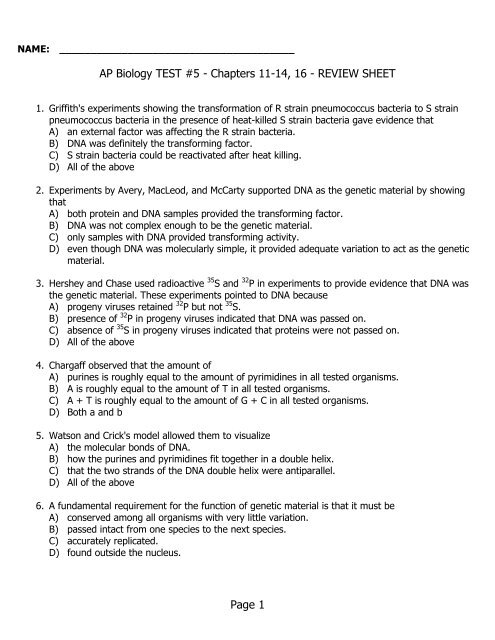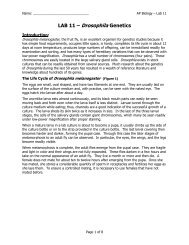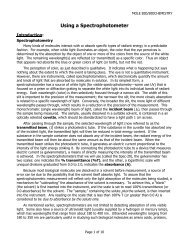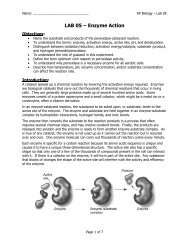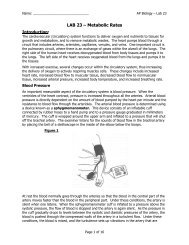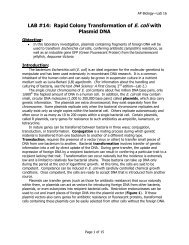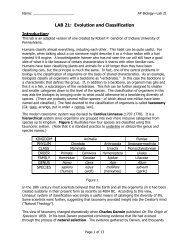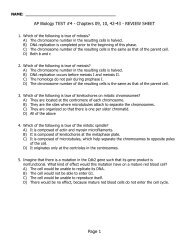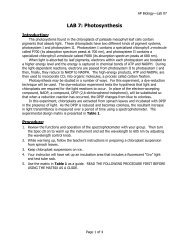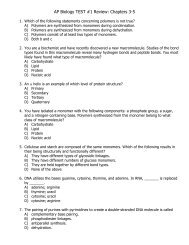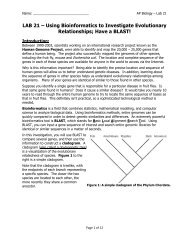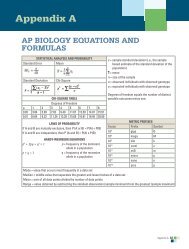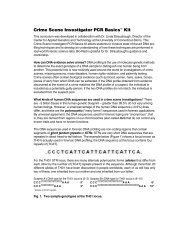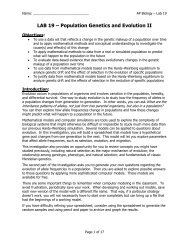Page 1 AP Biology TEST #5 - Chapters 11-14, 16 - REVIEW SHEET
Page 1 AP Biology TEST #5 - Chapters 11-14, 16 - REVIEW SHEET
Page 1 AP Biology TEST #5 - Chapters 11-14, 16 - REVIEW SHEET
- No tags were found...
Create successful ePaper yourself
Turn your PDF publications into a flip-book with our unique Google optimized e-Paper software.
NAME: ______________________________________<strong>AP</strong> <strong>Biology</strong> <strong>TEST</strong> <strong>#5</strong> - <strong>Chapters</strong> <strong>11</strong>-<strong>14</strong>, <strong>16</strong> - <strong>REVIEW</strong> <strong>SHEET</strong>1. Griffith's experiments showing the transformation of R strain pneumococcus bacteria to S strainpneumococcus bacteria in the presence of heat-killed S strain bacteria gave evidence thatA) an external factor was affecting the R strain bacteria.B) DNA was definitely the transforming factor.C) S strain bacteria could be reactivated after heat killing.D) All of the above2. Experiments by Avery, MacLeod, and McCarty supported DNA as the genetic material by showingthatA) both protein and DNA samples provided the transforming factor.B) DNA was not complex enough to be the genetic material.C) only samples with DNA provided transforming activity.D) even though DNA was molecularly simple, it provided adequate variation to act as the geneticmaterial.3. Hershey and Chase used radioactive 35 S and 32 P in experiments to provide evidence that DNA wasthe genetic material. These experiments pointed to DNA becauseA) progeny viruses retained 32 P but not 35 S.B) presence of 32 P in progeny viruses indicated that DNA was passed on.C) absence of 35 S in progeny viruses indicated that proteins were not passed on.D) All of the above4. Chargaff observed that the amount ofA) purines is roughly equal to the amount of pyrimidines in all tested organisms.B) A is roughly equal to the amount of T in all tested organisms.C) A + T is roughly equal to the amount of G + C in all tested organisms.D) Both a and b5. Watson and Crick's model allowed them to visualizeA) the molecular bonds of DNA.B) how the purines and pyrimidines fit together in a double helix.C) that the two strands of the DNA double helix were antiparallel.D) All of the above6. A fundamental requirement for the function of genetic material is that it must beA) conserved among all organisms with very little variation.B) passed intact from one species to the next species.C) accurately replicated.D) found outside the nucleus.<strong>Page</strong> 1
<strong>14</strong>. Which of the following represents a bond between a purine and a pyrimidine (in that order)?A) C–TB) G–AC) G–CD) T–A15. Which of the following statements about DNA replication is false?A) Okazaki fragments are synthesized as part of the leading strand.B) Replication forks represent areas of active DNA synthesis on the chromosomes.C) Error rates for DNA replication are often less than one in every billion base pairings.D) Ligases and polymerases function in the vicinity of replication forks.<strong>16</strong>. Which of the following would not be found in a DNA molecule?A) PurinesB) Ribose sugarsC) PhosphatesD) Sulfur17. If a nucleotide lacking a hydroxyl group at the 3 end were added to a PCR reaction, what wouldbe the outcome?A) No additional nucleotides would be added to a growing strand containing that nucleotide.B) Strand elongation would proceed as normal.C) Nucleotides would only be added at the 5 end.D) T. aquaticus DNA polymerase would be denatured.18. Transcription in prokaryotic cellsA) occurs in the nucleus, whereas translation occurs in the cytoplasm.B) is initiated at a start codon with the help of initiation factors and the small subunit of theribosome.C) is initiated at a promoter and uses only one strand of DNA, the template strand, to synthesizea comple mentary RNA strand.D) is terminated at stop codons.19. Which of the following about RNA polymerase is not true?A) It synthesizes mRNA in a 5-to-3 direction reading the DNA strand 3-to-5.B) It synthesizes mRNA in a 3-to-5 direction reading the DNA strand 5-to-3.C) It binds at the promoter and unwinds the DNA.D) It does not require a primer to initiate transcription.20. If a codon were read two bases at a time instead of three bases at a time, how many differentpossible amino acids could be specified?A) <strong>16</strong>B) 64C) 8D) 32<strong>Page</strong> 3
21. Translate the following mRNA:3-G A U G G U U U U A A A G U A- 5A) NH 2 met—lys—phe—leu—stop COOHB) NH 2 met—lys—phe—trp—stop COOHC) NH 2 asp—gly—phe—lys—val COOHD) NH 2 asp—gly—phe—lys—stop COOH22. What would happen if a mutation occurred in DNA such that the second codon of the resultingmRNA was changed from UGG to UAG?A) Nothing. The ribosome would skip that codon and translation would continue.B) Translation would continue, but the reading frame of the ribosome would be shifted.C) Translation would stop at the second codon, and no functional protein would be made.D) Translation would continue, but the second amino acid in the protein would be different.23. If the following synthetic RNA were added to a test tube containing all the components necessaryfor protein translation to occur, what would the amino acid sequence be?5-A U A U A U A U A U A U - 3A) PolyphenylalanineB) Isoleucine-tyrosine-isoleucine-tyrosineC) Isoleucine-isoleucine-isoleucine-isoleucineD) Tyrosine-tyrosine-tyrosine-tyrosine24. What part of the tRNA base-pairs with the codon in the mRNA?A) The 3 end, where the amino acid is covalently attachedB) The 5 endC) The anticodonD) The promoter25. Termination of translation requiresA) release factor, initiator tRNA, and ribosomes.B) initiation factors, the small subunit of the ribosome, and mRNA.C) elongation factors and charged tRNAs.D) a stop codon positioned at the A site of the ribosome, peptidyl transferase, and release factor.26. Which of the following mutations would probably be the most deleterious?A) A missense mutation in the second codonB) A frame-shift mutation in the second codonC) A nonsense mutation in the last codonD) A silent mutation in the second codon<strong>Page</strong> 4
27. If the DNA encoding a nuclear signal sequence were placed in the gene for a cytoplasmic protein,what would happen?A) The protein would be directed to the lysosomes.B) The protein would be directed to the nucleus.C) The protein would be directed to the cytoplasm.D) The protein would stay in the endoplasmic reticulum.28. The central dogma of molecular biology states that _______ is transcribed into _______, which istranslated into _______.A) genes; polypeptides; gene productB) protein; DNA; RNAC) DNA; mRNA; tRNAD) DNA; RNA; protein29. A gene product can be a(n)A) enzyme.B) polypeptide.C) RNA.D) All of the above30. The enzyme that catalyzes the synthesis of RNA isA) DNA polymerase.B) tRNA synthetase.C) ribosomal RNA.D) RNA polymerase.31. Viruses consist ofA) a protein core and a nucleic acid capsid.B) a cell wall surrounding nucleic acid.C) RNA and DNA enclosed in a membrane.D) a nucleic acid core surrounded by a protein capsid and in some cases a membrane.32. Bacterial cells that are resistant to virusesA) lack a cell surface receptor that the virus must bind to infect the cell.B) harbor a prophage in their chromosome, making the bacterial cell immune to further viralinfection.C) cannot be lysed by the bacteriophage.D) All of the above33. Lytic bacterial virusesA) infect the cell, replicate their genomes, and lyse the cell.B) infect the cell, replicate their genomes, transcribe and translate their genes, and lyse the cell.C) infect the cell, replicate their genomes, transcribe and translate their genes, package thosegenomes into viral capsids, and lyse the cell.D) infect the cell, translate their RNA, and lyse the cells.<strong>Page</strong> 5
34. Animal viruses that integrate their DNA into the host chromosomeA) are RNA viruses.B) are prophages.C) copy their RNA genome into DNA using reverse transcriptase.D) Both a and c35. During conjugation,A) DNA from one bacterial cell is transferred to another bacterial cell using a bacteriophage.B) mutants that are auxotrophic for one nutrient can be converted to prototrophs when mixedwith mutants that are auxotrophic for another nutrient.C) a pilus is synthesized, and DNA is transferred from one bacterium across the conjugation tubeto the recipient bacterium.D) Both b and c36. Plasmid DNA may contain genes that canA) confer drug resistance to the host cell.B) regulate conjugation.C) confer resistance to heavy metals.D) All of the above37. An operonA) is regulated by a repressor binding at the promoter.B) has structural genes that are all transcribed from same promoter.C) has several promoters, but all of the structural genes are related biochemically.D) is a set of structural genes all under the same translational regulation.38. If the gene encoding the lac repressor is mutated so that the repressor can no longer bind theoperator, will transcription of that operon occur?A) Yes, but only when lactose is present.B) No, because RNA polymerase is needed to transcribe the genes.C) Yes, because RNA polymerase will be able to bind the promoter and transcribe the operon.D) No, because cAMP levels are low when the repressor is nonfunctional.39. If the gene encoding the trp repressor is mutated such that it can no longer bind tryptophan, willtranscription of the trp operon occur?A) Yes, because the trp repressor can only bind the trp operon and block transcription when it isbound to tryptophan.B) No, because this mutation does not affect the part of the repressor that can bind the operator.C) No, because the trp operon is repressed only when tryptophan levels are high.D) Yes, because the trp operon can allosterically regulate the enzymes needed to synthesize theamino acid tryptophan.<strong>Page</strong> 6
47. The transcription complex includes _______ and _______.A) transcription factors; promotersB) regulator proteins; regulatorsC) repressor proteins; silencersD) Both a and b48. DNA binding proteinsA) have distinct three-dimensional structures that allow them to bind to the DNA.B) can be transcription factors.C) can help condense the DNA in the nucleus.D) All of the above49. Chromatin structure must be altered for gene expression to occur becauseA) condensed chromatin is replicated but not transcribed.B) condensed chromatin makes most DNA sequences inaccessible to the transcription complex.C) decondensed chromatin has more nucleosomes per DNA molecule.D) heterochromatin is actively transcribed and euchromatin is not transcribed.50. When DNA sequences are moved to new sites on a chromosome,A) new genes can be transcribed.B) genes can be inactivated.C) new genes can be created.D) All of the above51. Posttranscriptional regulation can includeA) binding of repressor on silencer regions.B) insertion and alteration of nucleotides.C) decreasing mRNA stability in the cytoplasm.D) Both b and c52. Genes can be inactivated byA) inaccurate removal of introns.B) transposable genetic elements.C) movement of genes to heterochromatic regions of the chromosome.D) All of the above53. Cloning a gene may involveA) restriction endonucleases and ligase.B) plasmids and bacteriophage .C) yeast artificial chromosomes and complementary base pairing.D) All of the above<strong>Page</strong> 8
54. Restriction endonucleasesA) are enzymes that process pre-mRNAs.B) are enzymes that degrade DNA.C) protect bacterial cells from viral infections.D) All of the above55. DNA fragments are separated using gel electrophoresisA) because DNA is pulled through the gel toward the negative end of the field.B) because larger DNA fragments move faster through the gel than smaller DNA fragments.C) to identify and isolate DNA fragments.D) to synthesize DNA for cloning.56. Complementary base pairing is important forA) ligation reactions with blunt-end DNA molecules.B) hybridization between DNA and transcription factors.C) restriction endonucleases to cut cell walls.D) synthesizing cDNA molecules from mRNA templates.57. For a prokaryotic vector to be propagated in a host bacterial cell, the vector needsA) telomeres.B) centromeres.C) drug-resistance genes.D) an origin of replication.58. Gene expression can be inhibited byA) antisense RNA.B) knockout genes.C) DNA chips.D) Both a and b59. DNA fingerprinting works becauseA) genes containing the same alleles make it simple to compare different individuals.B) PCR allows amplification of proteins from single cells.C) there are multiple alleles for some DNA sequences, making it possible to obtain uniquepatterns for each individual.D) DNA in the skin cells is very diverse.60. RNAiA) is more effective than antisense RNA in inhibiting translation.B) inhibits transcription in eukaryotes.C) is produced only by viruses.D) Both a and c<strong>Page</strong> 9
61. DNA chip technologies can be used toA) predict who will get cancer.B) show transcriptional patterns in an organism during different times of development.C) clone DNA.D) make transgenic plants.62. Given the following parent strand sequence, what would the daughter strand sequence look like?5 – G C T A A C T G T G A T C G T A T A A G C T G A – 363. Diagram the double helix. Be sure to label those properties that make it most suited as the geneticmaterial.64. Diagram a replication fork as it would be seen in a replicating segment of DNA. In your diagramlabel the 5 and 3 ends of each parent strand and daughter strand. Indicate which new strand isthe leading strand and which is the lagging strand of the daughter DNA.<strong>Page</strong> 10
65. Based on your diagram in Question 64, construct a flowchart that represents what occurs duringDNA replication. Divide your chart into three parts: initiation, elongation, and termination ofreplication. In your chart, indicate the roles of helicase, DNA polymerase, single-stranded DNAbinding proteins, nucleotides, parental (template) DNA strands, DNA ligase, RNA primase, and RNAprimers.66. Explain the difference between conservative and semiconservative models of DNA replication.What results supported the semiconservative model? What would the results have looked like hadthe conservative model of DNA replication been accurate? Are there any other potentialhypotheses?67. What would happen if the tRNA synthetase for tryptophan actually added a phenylalanine to thetrp tRNAs instead of tryptophan?68. Mutations can be very harmful to an organism, yet without them life as we know it today wouldnot exist. Explain.<strong>Page</strong> <strong>11</strong>
69. A mutation occurs in the promoter of a eukaryotic gene, eliminating the TATA box. How will thismutation affect the transcription of this gene?70. A different mutation eliminates the enhancer sequence on the DNA for this gene. How will thismutation affect the transcription of this gene?71. Describe one posttranscriptional regulatory event and one posttranslational regulatory event thatcontrols the level of gene expression in eukaryotic cells.72. Describe three useful products that have been produced using biotechnology. Outline two specificdangers that could result from producing organisms that contain foreign genes.<strong>Page</strong> 12
Use the following to answer questions 73-75:Below is a map of a fragment of 12-kilobase DNA with the locations of EcoRI (R) and BamHIII (H)restriction sites indicated. The numbers represent the distance in kilobases (kb = one thousand basepairs).73. Diagram - What fragments would result if the fragment were cut with EcoRI?74. Diagram - What fragments would result if the fragment were cut with BamHIII?75. Diagram - A researcher performing gel electrophoresis places the DNA digested with EcoRI inLane 1 and the DNA digested with BamHIII in Lane 2. What should the gel look like?<strong>Page</strong> 13
Answer Key1. A2. C3. D4. D5. D6. C7. C8. A9. D10. B<strong>11</strong>. A12. B13. B<strong>14</strong>. C15. A<strong>16</strong>. D17. A18. C19. B20. A21. B22. C23. B24. C25. D26. B27. B28. D29. D30. D31. D32. D33. C34. D35. D36. D37. B38. C39. A40. B41. D42. D43. C44. C45. D46. A47. D48. D49. B50. D51. D52. D53. D54. C55. C56. D57. D58. D59. C60. A61. B62. 3' – C G A T T G A C A C T A G C A T A T T C G A C T – 5'63. See Figure <strong>11</strong>.6 in the text.64. See Figure <strong>11</strong>.15 and <strong>11</strong>.<strong>16</strong> in the text.65. See Figure <strong>11</strong>.15 and <strong>11</strong>.<strong>16</strong> in the text.66. In the conservative model of DNA replication, the parent DNA remains intact, and a newlysynthesized molecule consists of two newly replicated daughter strands. Had this been DNA'smethod of replication, Meselson and Stahl would not have seen the intermediate density band inthe first generation of replication. They would have seen a heavy band corresponding to theparental DNA and a light band corresponding to the daughter DNA. Because they saw anintermediate band, they knew one strand was heavy and one was light; therefore, replication wassemiconservative, with each new molecule consisting of one parental strand and one daughterstrand. A third hypothesis was the dispersive model, with each new molecule containing bits andpieces of both old and new strands.<strong>Page</strong> <strong>14</strong>
67. If the tRNA synthetase for tryptophan added phenyla lanine to the trp tRNAs, everytime atryptophan codon was read by these trp tRNAs, phenylalanine would be added to the polypeptide.This would create proteins that were nonfunctional, and the cell would die.68. Mutations very often have damaging effects on a gene, rendering that gene product nonfunctional.Some mutations actually create gene products that are better for the cell or organism and mayincrease its ability to survive. Mutations over the course of evolutionary time have created neworganisms that could survive in different environments or compete more effectively for limitedresources. Without mutations evolution does not occur.69. If the TATA box of the promoter for a eukaryotic gene is deleted, transcription factor TFIID will notbind the promoter. The transcription complex will not assemble at the promoter and there will beno initiation of transcription.70. If the enhancer for a gene is deleted, transcription for that gene will still occur, but at a reducedrate.71. Posttranscriptional regulatory events can include events that affect splicing, mRNA stability andinhibition of translation by microRNAs. Posttranslational events can include modifying the G cap sothat the mRNA will be translated and protein degraded.72. Useful products include rice grains that produce -carotene, plants that are resistant to herbicidesand insect larvae, sheep that produce human blood-clotting factors and antibodies to colon cancerin their milk, and others (see Tables <strong>16</strong>.1 and <strong>16</strong>.2). Dangers include creating geneticallyengineered foods that could adversely affect human nutrition, the transfer of herbicide- andinsect-resistant genes from crop plants into noxious weeds, and the introduction into the wild ofnew organisms that might have unforeseen ecological consequences.73. There would be two fragments: one 3 kb long and the other 9 kb long.74. There would be three fragments with sizes of 2, 4, and 6 kb.75.<strong>Page</strong> 2


